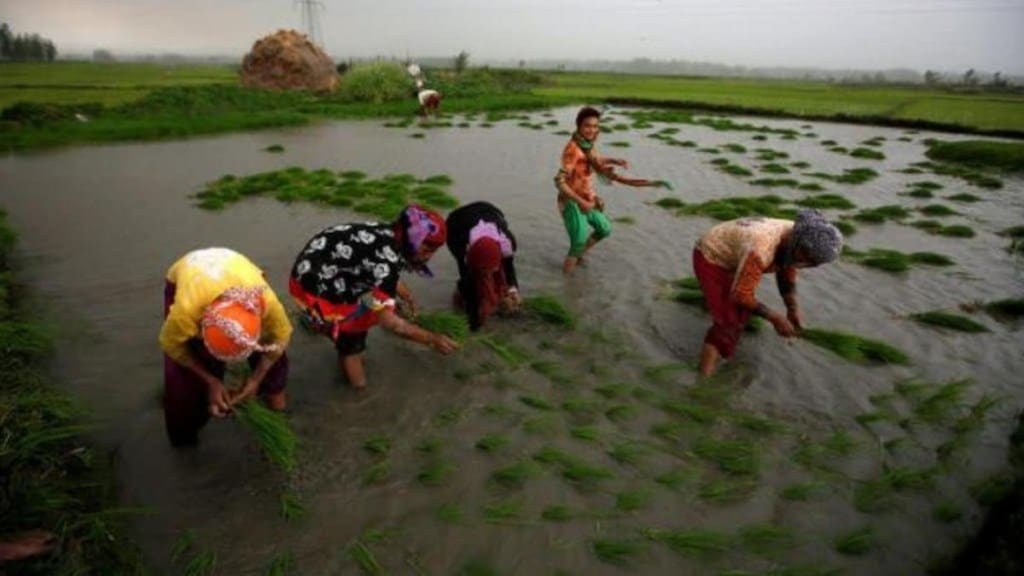The Cabinet on Wednesday approved an increase in the range of 1-9% in the minimum support prices (MSP) of major kharif crops for the 2025-26 kharif season (July-June), but raised the support price for paddy, by a modest 3% to Rs 2369/quintal. The hike in paddy support price for the next kharif season for which sowing is about to start, is the lowest in five years.
With a huge surplus of rice stocks in the central pool, the government is aiming to signal to the farmers to diversify to more remunerative crops like pulses and oilseeds, especially in norther like Punjab and Haryana.
“Due to today’s decision, farmers will get over Rs 2.07 lakh crore by the way of MSP this season,” information and broadcasting minister Ashwini Vaishnaw said.
Farmers’ income and the gross value added (GVA) in agriculture and allied sector are a function of multiple factors. Apart from MSP and actual quantities procured at support prices, these include crop output, price realisation by various stakeholders in the open market, and exports. Food grains production in the upcoming kharif season is projected to be a record of 354.64 million tonne (MT) food grains production in the 2025-26 crop year (July-June), up 4% from the target for the current (2024-25) crop year.
The country is likely to achieve a 3.5% farm sector growth rate during 2025-26, Union agriculture minister Shivraj Singh Chouhan said recently. GVA in agriculture and allied sectors grew by robust 3.8% (second advance estimates) in FY25, as compared with 1.4% in FY24.
Currently, rice stocks at the central pool is 37.9 million tonne (MT). Effectively, the Food Corporation of India holds over 59 MT – including 21 MT of grain receivable from millers – four times the buffer of 13.54 MT for July 1.
The announcement of MSPs comes just after Indian Meteorological Department reiterated its forecast above-normal monsoon rains during June-September period which is expected to boost sowing of kharif crops – paddy, pulses, oilseeds, coarse cereals and cotton.
The MSP for tur for 2025-26 season will be Rs 8000/quintal, up 6% on year.
However, traders said while the current market prices remain significantly lower, ranging between Rs 6,500/quintal to Rs 6,700/quintal, imported tur is even cheaper, with Myanmar-origin priced around Rs 6,300/quital and African-origin around Rs 5,600/quintal, significantly below the MSP of Rs 7550/quintal.
“Unfortunately, only about 20% of farmers actually benefit from MSP procurement. To ensure farmers truly receive MSP and better returns, procurement operations must be strengthened in tandem with a review of import policies,” Nitin Kalantri, MD, Kalantry Food, a Latur, Maharashtra based leading processor of tur, told FE.
India imported over 1.1 MT of tur from several countries including Myanmar, Mozambique, Malawi and Tanzania in 2024-25. The duty free import regime has been extended till March 31, 2026
Moong MSP has been hiked marginally by less 1% to Rs 8768/quintal while remunerative price for urad has been hiked by 5% to Rs 7800/quintal for next kharif season.
“With urad production steadily declining in recent years, this move sends a strong signal to farmers that pulses cultivation is a priority. It will encourage growers to shift back to urad and expand sowing in the upcoming kharif season,” Harsha Rai, Head, Mayur Global Corporation, a leading pulses trading firm said.
In 2018-19, the government adopted the policy of MSPs to ensure at least 50% profits over computed cost of production of crops. In that year, MSP hikes for kharif crops were in the range of 4.1 – 28.1%, the highest.
The higher value of MSP for pulses and oilseeds, if translated into procurement, will drive the gross value added (GVA) in “agriculture and allied services”.
Elevated MSPs. backed by procurement, could potentially boost rural income and purchasing power.
MSP purchases are more robust for paddy and wheat, than for other crops like oilseeds and pulses.
India imports 15-18% of its pulses consumption. The MSP of soybean, a key oilseed, has been hiked the highest amongst the major crops by 8.9% to Rs 5328/quintal for next season on year. India imports 57% of its cooking oil consumption.
The MSP for medium staple variety of cotton, a major cash crop grown in the kharif season, has been raised by 8% to Rs 7710/quintal for the next season. The MSP of other cereals such as maize (7.8%), bajra (5.4%), ragi (12%) and jowar (8.8) has been hiked by for the next sowing season.
The cost of production for computation of MSP includes all paid-out directly incurred by the farmers – in cash and kind – on seeds, fertiliser, pesticides, hired labour, leased-in land, fuel and irrigation and an imputed value of unpaid family labour.
The expected margin to farmers over their cost of production in 2025-26 are estimated to be highest in case of bajra (63%), followed by tur (59%), masur (59%) and urad (53%). For the rest of the crop, margin to farmers over the production cost is estimated at 50%.

